<Back to Index>
- Commander of the II Corps General Rowland Hill, 1st Viscount Hill of Almaraz, 1772
- Commander of Cavalry and Horse Artillery Field Marshal Henry William Paget, 1st Marquess of Anglesey, 1768
- Commander of the 5th Infantry Division Lieutenant General Thomas Picton, 1758
PAGE SPONSOR
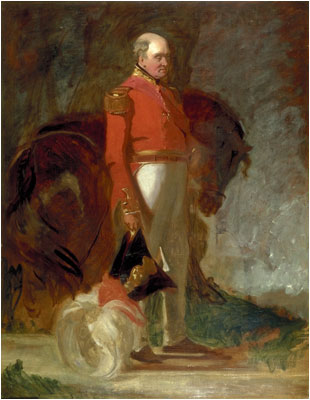
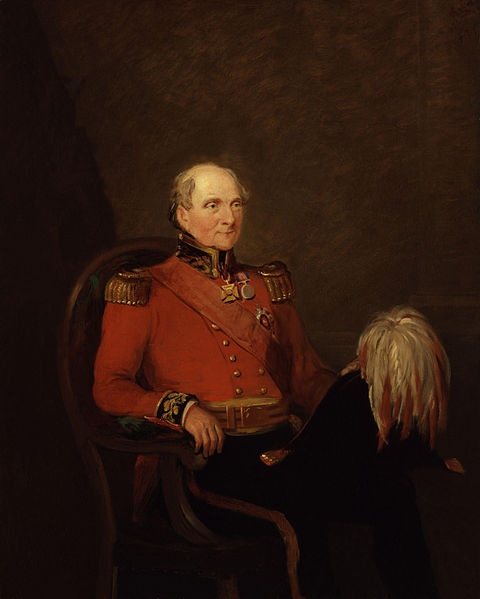
General Rowland Hill, 1st Viscount Hill of Almaraz GCB, GCH (11 August 1772 – 10 December 1842) served in the Napoleonic Wars as a trusted brigade, division and corps commander under the command of the Duke of Wellington. He became Commander - in - Chief of the British Army in 1829.
Educated at The King's School in Chester, Hill was commissioned into 38th Foot in 1790. He went on to serve at the siege of Toulon in 1793 from where he carried the dispatches to London. In 1794 he assisted Thomas Graham in raising the 90th Foot for which he was promoted to major and shortly afterwards to lieutenant colonel.
In 1801 he commanded the 90th Foot when they landed at Abu Qir Bay in Egypt as part of a force under Sir Ralph Abercromby: Hill was seriously wounded in the action when a musket ball hit his head. In the ensuing weeks Hill helped drive the French forces out of Egypt. Hill became a brigadier in 1803 and a major general in 1805.
Hill commanded a brigade at the Battle of Roliça and also at the Battle of Vimeiro in 1808. He participated in Sir John Moore's 1808 - 1809 campaign in Spain, commanding a brigade at the Battle of Corunna. While serving under Wellington at the Second Battle of Porto, units of Hill's brigade launched an impromptu assault across the Douro River that ultimately routed Marshal Nicolas Soult's French corps from Oporto.
Hill commanded the 2nd Infantry Division at the Battle of Talavera. The night before the battle, Marshal Claude Victor mounted a surprise attack, swept aside two battalions of the King's German Legion and seized a key elevation. As Hill later recounted, "I was sure it was the old Buffs, as usual, making some blunder." Nevertheless, he led a reserve brigade forward in the dark. In the short clash that followed, Hill was briefly grabbed and nearly captured by a Frenchman, but his troops recovered the summit. This is the first occasion on which Hill supposedly swore.
Still leading the 2nd Division during Marshal André Masséna's 1810 invasion of Portugal, Hill fought at the Battle of Bussaco. In autumn 1811, Wellington placed Hill in independent command of 16,000 men watching Badajoz. On 28 October he led a successful raid on the French at the Battle of Arroyo dos Molinos. In May 1812, after the capture of Badajoz, Hill led a second raid that destroyed a key bridge in the Battle of Almaraz. While Wellington won the Battle of Salamanca, Hill protected Badajoz with an independent 18,000 man corps, including the British 2nd Division, John Hamilton's Portuguese division and William Erskine's 2nd Cavalry Division.
After the British capture of Madrid, Hill had responsibility for an army of 31,000 Anglo - Portuguese and 12,000 Spanish troops during the campaign that centered on the Siege of Burgos. When the French massed superior forces against the British in the autumn of 1812, Hill safely brought his army back from Madrid to join the main army under Wellington near Alba de Tormes.
Hill commanded the Right Column during the campaign and decisive British victory at the Battle of Vitoria on 21 June 1813. Still in corps command, he fought in the Battle of the Pyrenees. At Vitoria and in Wellington's invasion of southern France, Hill corps usually consisted of William Stewart's 2nd Division, the Portuguese Division (under John Hamilton, Francisco Silveira or Carlos Le Cor) and Pablo Morillo's Spanish Division. He led the Right Corps at the Battle of Nivelle on 10 November.
On 13 December 1813, during the Battle of the Nive, Hill performed what may have been his finest work in his defense of St-Pierre d'Irube. With his 14,000 men and 10 guns isolated on the east bank of the Nive by a broken bridge, Hill held off the attacks of Marshal Nicolas Soult's 30,000 soldiers and 22 guns. He fought the battle with great skill and "was seen at every point of danger, and repeatedly led up rallied regiments in person to save what seemed like a lost battle ... He was even heard to swear." Later, he fought at the Orthez and Toulouse. Wellington said, "The best of Hill is that I always know where to find him."
Nicknamed "Daddy Hill", he looked after his troops and was adored by his men. On one occasion, he provided a wounded officer who arrived at his headquarters with a lunch basket. Another time, a sergeant delivered a letter to Hill. Expecting nothing but a nod of thanks, the man was astonished when the general arranged for his supper and a place for him to stay for the night. The next day, Hill gave him food and a pound for the rest of his journey.
He was also Member of Parliament (MP) for Shrewsbury from 1812 to 1814.
At the Battle of Waterloo Hill commanded the II Corps. He led the famous charge of Sir Frederick Adam's brigade against the Imperial Guard towards the end of the battle. For some time it was thought that he had fallen in the melee. He escaped unwounded, however, and continued with the army in France until its withdrawal in 1818.
On 27 August 1815 the Dutch King William I made him a Commander of the exclusive Military Order of William. At the Coronation of George IV in 1821, Lord Hill bore the Standard of England in the procession from Westminster Hall to Westminster Abbey. From 1828 to 1839, he succeeded the Duke of Wellington as Commander - in - Chief of the Forces.
A keen foxhunter, Rowland Hill was master of the North Shropshire Foxhounds until 1823. The pack exists to this day and hunts the north of the County, including the grounds of his birth place, Hawkstone Hall. He later shared the Mastership with Sir Bellingham - Graham and Sir Edward Smythe, the hounds at this time being kenneled two miles south - east of Hawkstone Hall. Rowland Hill also formed the Hawkstone Otter Hunt around 1800, which was maintained and hunted by successive Lords.
He died at Hardwicke Grange, Hadnall, Shropshire, on 10 December 1842. He is buried in the graveyard at Hadnall, Shropshire.
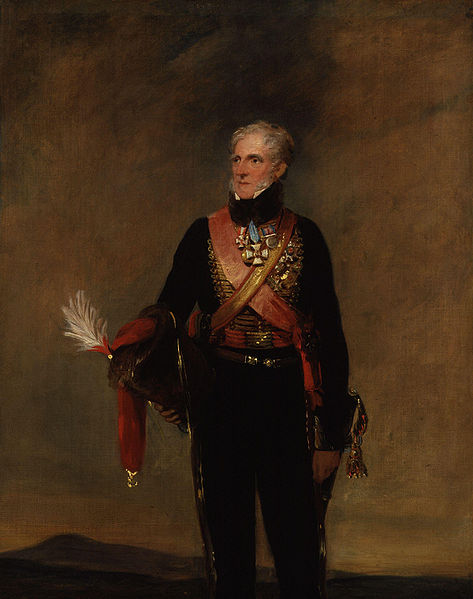
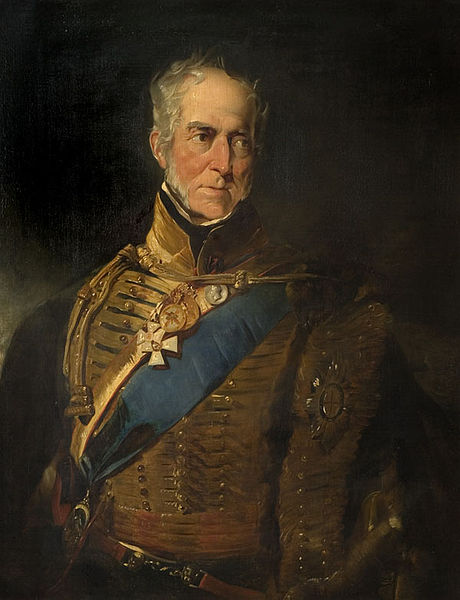
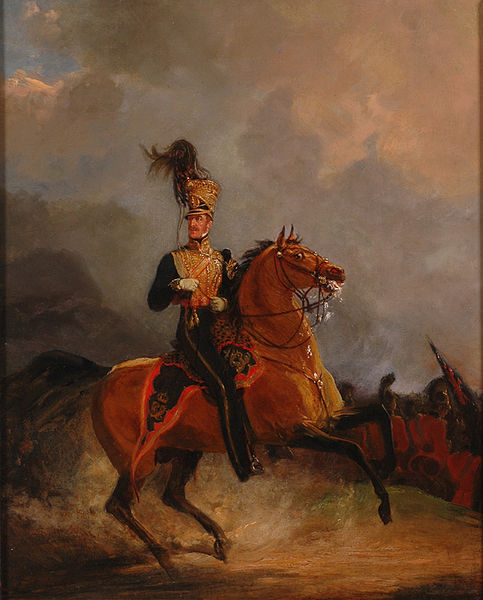
Field Marshal Henry William Paget, 1st Marquess of Anglesey, KG, GCB, GCH, PC (17 May 1768 – 29 April 1854), styled Lord Paget between 1784 and 1812 and known as The Earl of Uxbridge between 1812 and 1815, was a British military leader and politician, now chiefly remembered for leading the charge of the heavy cavalry against d'Erlon's column during the Battle of Waterloo. He also served twice as Master General of the Ordnance and twice as Lord Lieutenant of Ireland.
Born in London, as Henry Bayly (his father assumed the name Paget in 1770), he was the eldest son of Henry Paget, 1st Earl of Uxbridge, by his wife Jane, daughter of the Very Reverend Arthur Champagné, Dean of Clonmacnoise, Ireland. Captain William Paget, Sir Arthur Paget, General Sir Edward Paget, Vice Admiral Sir Charles Paget and Berkeley Paget were his younger brothers. He was educated at Westminster School and Christ Church, Oxford.
Paget entered parliament at the 1790 general election as member for Carnarvon, a seat he held until the 1796 general election when his brother Edward was elected unopposed in his place. He then represented Milborne Port from 1796 until he resigned his seat in 1804 by appointment as Steward of the Chiltern Hundreds, and again from the 1806 election to January 1810, when he took the Chiltern Hundreds again.
At the outbreak of the French Revolutionary Wars, Paget raised the regiment of Staffordshire volunteers and was given the temporary rank of lieutenant colonel in 1793. As the 80th Foot, the corps took part in the Flanders campaign of 1794 under Paget's command. In 1795 he was made a lieutenant colonel of the 16th Light Dragoons; in that same year, he married the daughter of George Villiers, 4th Earl of Jersey. In 1796 he was made a colonel, and by 1801 he had become colonel of the 7th Light Dragoons. In 1802 he was promoted major general, and six years later lieutenant general. He commanded the cavalry for Sir John Moore's army during the 1809 Corunna campaign, wherein his troopers provided excellent rear guard defense during the long retreat. The British cavalry showed a distinct superiority over their French counterparts at the action of Sahagun and routed the Chasseurs a Cheval of the Imperial Guard at Benevente.
This was his last service in the Peninsular War, because his liaison with Lady Charlotte, the wife of Henry Wellesley, afterwards Lord Cowley, made it impossible subsequently for him to serve with Wellington, Wellesley's brother. His only war service from 1809 to 1815 was in the disastrous Walcheren expedition (1809), in which he commanded a division.
In 1810 he was divorced and then married Lady Charlotte Wellesley, who
had at about the same time been divorced from her husband.
In 1815, he was appointed cavalry commander in Belgium, under the still resentful eye of Wellington. On the eve of Waterloo, Paget had his command extended by Wellington so as to include the whole of the allied cavalry and horse artillery. He handily covered the retirement of the Anglo - Allies from Quatre Bras to Waterloo on 17 June, and on 18 June led the spectacular cavalry charge of the British center, which checked and in part routed D'Erlon's corps d'armée.
One of the last cannon shots fired that day hit Paget in the right leg, necessitating its amputation. According to anecdote, he was close to Wellington when his leg was hit, and exclaimed, "By God, sir, I've lost my leg!" — to which Wellington replied, "By God, sir, so you have!" According to his aide - de - camp, Thomas Wildman, during the amputation Paget smiled and said, "I have had a pretty long run. I have been a beau these 47 years and it would not be fair to cut the young men out any longer."
He was to have an articulated artificial limb fitted by James Potts. Lord Uxbridge's amputated leg had a somewhat macabre after - life.
Paget was appointed a Knight Grand Cross of the Order of the Bath in January 1815, and on 4 July 1815, just over two weeks after Waterloo, the Prince Regent created him Marquess of Anglesey. He was also made a Knight of the Order of St George of Russia and a Knight of the Order of Maria Theresa of Austria the same year. In 1816 he was also appointed a Knight Grand Cross of the Royal Guelphic Order and in 1818 he was made a Knight of the Garter. A 27m high monument to his heroism (designed by Thomas Harrison) was erected at Llanfair PG on Anglesey, close to his country retreat at Plas Newydd, in 1816.
A separate monument to Uxbridge's leg was erected at Waterloo, but the bones were later disinterred and put on display.
In 1819 Anglesey became full general, and at the coronation of George IV, he acted as Lord High Steward of England. His support of the proceedings against Queen Caroline, alleging her infidelity, made him for a time unpopular, and when he was on one occasion beset by a crowd, who compelled him to shout "The Queen!", he added the wish, "May all your wives be like her." In April 1827, he became a member of the Canning administration, taking the post of Master General of the Ordnance and becoming a member of the Privy Council. Under the Wellington administration, he accepted the appointment of Lord Lieutenant of Ireland (March 1828).
In December 1828, he addressed a letter to the Roman Catholic primate
of Ireland stating his belief in the need for Catholic emancipation, which led to his recall by the government; on the formation of Earl Grey's administration in November 1830, he again became lord lieutenant of Ireland. In July 1833, the ministry resigned over the Irish question, he spent thirteen years out of office, then joined Lord John Russell's administration in July 1846 as master general of the ordnance, finally retiring in March 1852 with the rank of field marshal and colonel of the Royal Horse Guards. He also held the honorary posts of Lord Lieutenant of Anglesey between 1812 and 1854 and Lord Lieutenant of Staffordshire between 1849 and 1854.
Lord Anglesey was first married on 5 July 1795 in London to Lady Caroline Elizabeth Villiers (16 December 1774 - 16 June 1835), daughter of George Villiers, 4th Earl of Jersey and Frances Villiers, Countess of Jersey. They had eight children:
- Lady Caroline Paget (6 June 1796 - 12 March 1874). Married Charles Gordon - Lennox, 5th Duke of Richmond.
- Henry Paget, 2nd Marquess of Anglesey (6 July 1797 - 7 February 1869). Married Eleanora Campbell, granddaughter of John Campbell, 5th Duke of Argyll.
- Lady Jane Paget (13 October 1798 - 28 January 1876). Married Francis Conyngham, 2nd Marquess Conyngham.
- Lady Georgina Paget (29 August 1800 - 9 November 1875). Married Edward Crofton, 2nd Baron Crofton.
- Lady Augusta Paget (26 January 1802 - 6 June 1872). Married Arthur Chichester, 1st Baron Templemore.
- Captain Lord William Paget RN (1 March 1803 - 17 May 1873). Married Frances de Rottenburg, a daughter of Francis de Rottenburg.
- Lady Agnes Paget (11 February 1804 - 9 October 1845). Married George Byng, 2nd Earl of Strafford. They were parents to George Byng, 3rd Earl of Strafford, Henry Byng, 4th Earl of Strafford and Francis Byng, 5th Earl of Strafford.
- Lord Arthur Paget (31 January 1805 - 28 December 1825).
Lord Anglesey and Lady Caroline were divorced on 29 November 1810. The same year, he married secondly to Lady Charlotte Cadogan (born 12 July 1781), former wife of Lord Henry Wellesley and daughter of Charles Sloane Cadogan, 1st Earl Cadogan. and Mary Churchill. Mary was a granddaughter of Lady Maria Walpole, an illegitimate daughter of Robert Walpole and Maria Skerret. They had ten children, of whom six survived infancy:
- Lady Emily Paget (4 March 1810 - 6 March 1893). Married John Townshend, 1st Earl Sydney.
- Lord Clarence Paget (17 June 1811 - 22 March 1895). Married Martha Stuart, the youngest daughter of Admiral Sir Robert Waller Otway.
- Lady Mary Paget (16 June 1812 - 20 February 1859). Married John Montagu, 7th Earl of Sandwich. They were parents of Edward Montagu, 8th Earl of Sandwich.
- Lord Alfred Paget (29 June 1816 - 24 August 1888).
- Lord George Paget (16 March 1818 - 30 June 1880). A Brigadier General of the British Army.
- Lady Adelaide Paget (Jan, 1820 - 21 August 1890). Married Frederick William Cadogan, a son of George Cadogan, 3rd Earl Cadogan and his wife Honoria Louisa Blake.
- Lord Albert Paget (Dec 1821 - Apr 1822)
- Lord Albert Paget (29 May 1823 - d. an infant)
- Lady Eleanor Paget (21 May 1825 - d. an infant)
Lady Anglesey died on 8 July 1853, aged 71. Lord Anglesey survived
her by less than a year and died on 29 April 1854, aged 85. He was
succeeded by his eldest son from his first marriage, Henry.
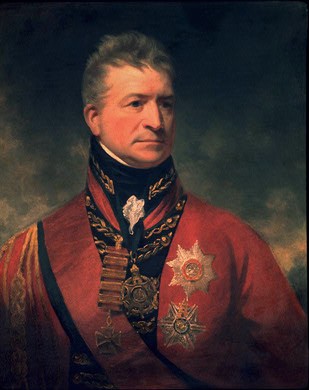
Lieutenant General Sir Thomas Picton GCB (August 1758 – 18 June 1815) was a Welsh British Army officer who fought in a number of campaigns for Britain, and rose to the rank of lieutenant general. According to the historian Alessandro Barbero, Picton was "respected for his courage and feared for his irascible temperament." He is chiefly remembered for his exploits under the Duke of Wellington in the Iberian Peninsular War and at the Battle of Waterloo, where he was mortally wounded while his division stopped d'Erlon's corps attack against the allied center left, and as a result became the most senior officer to die at Waterloo.
Picton was the younger son of Thomas Picton, and was born in Poyston, Pembrokeshire, Wales. In 1771 he obtained an ensign's commission in the 12th Regiment of Foot, but he did not join until two years later. The regiment was then stationed at Gibraltar, where he remained until he was made captain in the 75th in January 1778, at which point he then returned to Britain.
The regiment was disbanded five years later, and Picton quelled a
mutiny amongst the men by his prompt personal action and courage, and
was promised the rank of major
as a reward. He did not receive it, and after living in retirement on
his father's estate for nearly twelve years, he went out to the West Indies in 1794 on the strength of a slight acquaintance with Sir John Vaughan, the commander - in - chief, who made him his aide - de - camp and gave him a captaincy in the 17th foot. Shortly afterwards he was promoted major in the 58th foot.
Under Sir Ralph Abercromby, who succeeded Vaughan in 1795, he was present at the capture of St Lucia (after which he was promoted to lieutenant colonel of the 56th Foot) and then that of St Vincent.
After the reduction of Trinidad, Abercromby made Picton governor of the island. For the next 5 years he held the island with a garrison he considered inadequate against the threats of internal unrest and of reconquest by the Spanish. He ensured order by vigorous action, viewed variously as rough and ready justice or as arbitrary brutality. In October 1801 he was gazetted brigadier general. During the negotiations leading to the Peace of Amiens, many of the British inhabitants petitioned against the return of the island to Spain; this together with Picton's and Abercromby's representations, ensured the retention of Trinidad as a British possession.
By then, reports of arbitrariness and brutality associated with his governorship had led to a demand at home for his removal. (Picton was also making money from speculation in land and slaves and his mulatto mistress was believed to be corruptly influencing his decisions.) Furthermore, Trinidad no longer faced any external threat, the Pitt ministry had fallen and the new Addington administration did not want Trinidad to develop the plantation economy Picton favored. In 1802, William Fullarton (1754 – 1808) was appointed as the Senior Member of a commission to govern the island, Samuel Hood became the second member, and Picton himself the junior.
Fullarton had a very different background from Picton. He came from a wealthy and long established Scots land owning family and was a Whig MP, a Fellow of the Royal Society, an improving landlord, and a patron of Robert Burns. He had been a junior diplomat, before in the course of the American War of Independence raising a regiment of which he naturally became the Colonel. He ended that war in India commanding an army of 14,000 men in operations against Tippu Sultan. following which he had written an influential pamphlet arguing that the East India Company had brought trouble on itself by its unprincipled treatment of native princes and native subjects and that a more humane policy than "let them hate so long as they fear" would be more effective in securing its position. The new Secretary of State for the Colonies (Lord Hobart) had served as Governor of Madras soon after the pamphlet came out, knew Fullarton, and had been influenced by his views.
Picton's policy with respect to various sections of the island population had effectively been "let them hate so long as they fear" and he and Fullarton rapidly fell out. (This, of itself, further worsened the rift: Fullarton's Indian pamphlet had also reported adversely on conflicts of interest and dissension between the English having weakened their ability to govern well, to negotiate effectively, and to effectively defend their possessions.) Fullarton commenced a series of open inquiries on allegations against Picton and reported his unfavorable views on Picton's past actions at length to meetings of the commission. Picton thereupon tendered his resignation and was soon followed by Hood (1803).
Picton joined Hood in military operations in St Lucia and Tobago, before returning to Britain to face charges brought by Fullarton. In December 1803 he was arrested by order of the Privy Council and promptly released on bail set at £40,000 (Picton was able to give surety for half of this; two West Indies plantation owners covered the remainder).
The majority of the charges against Picton were dealt with by the
Privy Council. They related principally to excessive cruelty in the
detection and punishment of practitioners of obeah,
severity to slaves, and of execution of suspects out of hand without
due process. Only the latter class of charge seems to have seriously
worried the Privy Council, and here Picton's argument that either the
laws of Trinidad, then still the laws of the former Spanish colonial
power, or 'the state of the garrison' justified the immediate execution
in the cases specified eventually carried the day.
He was, however, tried in the court of King's Bench before Lord Ellenborough in 1806 on a single charge; the misdemeanor of having in 1801 caused torture to be unlawfully inflicted to extract a confession from Luisa Calderon, a young free mulatto girl suspected of assisting one of her lovers to burgle the house of the man with whom she was living, making off with about £500. Torture (but not the specific form) had been requested in writing by a local magistrate and approved in writing by Picton. The torture applied ("picketing") was a version of a British military punishment and consisted in principle of compelling the trussed up suspect to stand on one toe on a flat - headed peg for one hour on many occasions within a span of a few days. In fact Luisa was subjected to one session of 55 minutes, and a second of 25 minutes the following day.
The period between Picton's return and the trial had seen a pamphlet war between the rival camps, and the widespread sale of engravings showing a curious British public what a personable 14 year old mulatto girl being trussed up and tortured in a state of semi - undress might look like. The legal arguments, however, revolved on whether Spanish law permitted torture of suspects: on the evidence given, the jury decided that it did not and Picton was found guilty.
Picton promptly sought a retrial, which he got in 1808. At this,
other credible witnesses were brought forward by Picton's supporters to
testify to the (Spanish) legality of torture, its application in the
recent past, and that Luisa Calderon had been old enough to be legally
tortured. The jury reversed the verdict of the earlier trial but asked
for the full court to consider the further argument of the prosecution
that torture of a free person was so repugnant to the laws of England
that Picton must have known he could not permit it,
whatever Spanish law authorized. (The full court never reached a
decision on this; there were legal precedents to this general effect
from the British occupation of Minorca — and a practical precedent from the British seizure of the Cape of Good Hope
from the Dutch, but it remained to demonstrate that Picton should have
known this, and by now Fullarton was dead and Picton a war hero.)
Friends of Picton in the military and among slave owners subscribed
towards his legal expenses. Picton contributed the same sum to a relief
fund after a widespread fire in Port of Spain. He had meanwhile been promoted major general, and in 1809 he had been governor of Flushing in the Netherlands during the Walcheren expedition.
In 1810, at Wellington's request, he was appointed to command a division in Spain. For the remaining years of the Peninsular War, Picton was one of Wellington's principal subordinates. The commander - in - chief, it is true, never reposed in him the confidence that he gave to Beresford, Hill and Robert Craufurd. But in the resolute, thorough and punctual execution of a well defined task Picton had no superior in the army. His debut, owing partly to his naturally stern and now embittered temper, and partly to the difficult position in which he was placed, was unfortunate. On the River Coa in July 1810 Craufurd's division became involved in an action, and Picton, his nearest neighbor, refused to support him, as Wellington's direct orders were to avoid an engagement. Shortly after this, however, at Busaco, Picton found and used his first great opportunity for distinction. Here he had a plain duty, that of repulsing the French attack, and he performed that duty with a skill and resolution, which indicated his great powers as a troop leader.
After the winter in the lines of Torres Vedras, he added to his reputation and to that of his division, the 'Fighting' 3rd, at the Battle of Fuentes de Onoro. In September he was given the local rank of lieutenant general, and in the same month the division won great glory by its rapid and orderly retirement under severe pressure from the French cavalry at El Bodon. In October Picton was appointed to the colonelcy of the 77th Regiment of Foot.
In the first operations of 1812 Picton and Craufurd, side by side for the last time, stormed the two breaches of Ciudad Rodrigo, Craufurd and Picton's second in command, Major General Henry Mackinnon, being mortally wounded. At Badajoz, a month later, the successful storming of the fortress was due to his daring self - reliance and penetration in converting the secondary attack on the castle, delivered by the 3rd Division, into a real one. He was himself wounded in this terrible engagement, but would not leave the ramparts, and the day after, having recently inherited a fortune, he gave every survivor of his command a guinea. His wound, and an attack of fever, compelled him to return to Britain to recoup his health, but he reappeared at the front in April 1813. While in Britain he was invested with the collar and badge of a Knight of the Order of the Bath by the Prince Regent George, and in June he was made a lieutenant general in the army.
At the Battle of Vitoria, Picton led his division across a key bridge under heavy fire. According to Picton, the enemy responded by pummeling the 3rd with 40 to 50 cannon and a counter - attack on their right flank (which was still open because they had captured the bridge so quickly) causing the 3rd to lose 1,800 men (over one third of all Allied losses at the battle) as they held their ground. The conduct of the 3rd division under his leadership at the battle of Vittoria and in the engagements in the Pyrenees raised his reputation as a resolute and skilful fighting general to a still higher point. Early in 1814 he was offered, but after consulting Wellington declined, the command of the British forces operating on the side of Catalonia. He thus bore his share in the Orthez campaign and in the final victory before Toulouse.
On the break-up of the division the officers presented Picton with a
valuable service of plate, and on 24 June 1814 he received for the
seventh time the thanks of the House of Commons
for his great services. Somewhat to his disappointment he was not
included amongst the generals who were raised to the peerage, but early
in 1815 he was made a G.C.B.
When Napoleon returned from Elba, Picton, at Wellington's request, accepted a high command in the Anglo - Dutch army. He was severely wounded at Quatre Bras on 16 June, but concealed his wound and retained command of his troops. At Waterloo two days later, while in command of the 5th Infantry Division, while repulsing with impetuous valor "one of the most serious attacks made by the enemy on our position," he was shot through the temple by a musket ball, making him the highest ranking victim of the battle on the allied side. Since his luggage had not arrived in time, he had fought the battle wearing civilian clothes and a top hat. Welsh folklore says that his top hat was shot off by a cannon ball moments before his death, but this is not known to be backed by any historical source. Family folklore contends that he did not ride out in tails but in his night shirt and top hat because he had overslept, and he died at the hands of one of his own men who shot him in the back of the head because they hated him so much. Again this is not backed by any historical source.
Announcing his death in his typically laconic style, Wellington wrote to Minister of War, Lord Bathurst:
Your lordship will observe, that such a desperate action could not be fought, and such advantages could not be gained, without great loss; and, I am sorry to add, that ours has been immense. In Lieutenant - general Sir Thomas Picton, his majesty has sustained the loss of an officer who has frequently distinguished himself in his service; and he fell, gloriously leading his division to a charge with bayonets, by which one of the most serious attacks made by the enemy of our position was defeated.
His body was brought home to London, and buried in the family vault at St George's, Hanover Square. A public monument was erected to his memory in St Paul's Cathedral, by order of parliament, and in 1823 another was erected at Carmarthen by subscription, the king contributing a hundred guineas.
- The town of Picton in Prince Edward County, Ontario, Canada, was named in his honor.
- The town of Picton, New Zealand, was named in his honor.
- Picton, New South Wales, is a town named in his honor by his military colleague, Lachlan Macquarie
- Picton Road is a Highway in Australia
- Picton Road is located in the Laventille area of Port of Spain, in Trinidad.
- Picton Barracks, Bulford, Wiltshire, is HQ of UK 3 Div
- The Picton, a boys boarding house at Wellington College, Crowthorne, UK, which is an English co-educational public school founded by Queen Victoria and Prime Minister The Earl of Derby in 1859 as the national monument to Britain's greatest military figure, the Duke of Wellington.
- A First World War Royal Navy Lord Clive - class monitor was named HMS Sir Thomas Picton in his honor.
- Sir Thomas Picton School (Ysgol Sir Thomas Picton) is a mixed comprehensive school in Haverfordwest, Pembrokeshire, Wales.
- Picton Street, Montpelier, Bristol, was built and named in honor of Sir Thomas Picton who, as mere Captain Picton, in 1783 endeared himself to Bristolians by bravely facing the rebellious 75th Battalion on College Green, Bristol, and averting a military mutiny. There is also a fine double - bayed villa in the street named after him, Picton Lodge.
- There is a General Picton Inn in Porthcawl, a General Picton public house in Picton Place, Nantyffyllon, Maesteg, Mid Glamorgan. The public house sign contains an image of Thomas Picton. The area also contains a Picton Street also named after him. He owned a large amount of land very close to The General Picton public house.
- The Picton is public house on Commercial Road in Newport, Gwent. The sign outside depicts Sir Thomas in military uniform resting the blade of his sword upon his left shoulder.